|
McCloud River Subsidiaries and Affiliates Ahnapee and Western Railway Company |
|
|
|
The story of how the McCloud River Railroad developed a satellite operation two thirds of the way across the continent started in 1851 when European settlers
established a town they named Wolf River at the mouth of a river on the east side of Wisconsin's Door Peninsula that separates Green Bay from Lake
Michigan. The name of the town and the river changed in 1859 to Ahnapee, after a local native legend of a great gray wolf named Ah-ne-pe. The Door Peninsula developed a thriving economy based around agriculture, fishing, supporting maritime trade on the Great Lakes, and a small timber industry built around the hardwood forests in the peninsula interior. An entrepreneur named Edward Decker determined he needed a railroad to support his other businesses on the peninsula, and on 18 August 1890 he incorporated the first of several companies that would hold the Ahnapee and Western Railway name. The A&W established a connection with the Green Bay & Western Railroad at Casco Junction on that road's line that ran from Green Bay east to Kewaunee on the shore of Lake Michigan. The new road built north, reaching Ahnapee in August 1892 and Sturgeon Bay in July 1894. This last extension required the road to cross the Sturgeon Bay Ship Canal, which it accomplished by securing permission to lay rails across the Sturgeon Bay Swing Bridge, a wooden toll bridge built in 1887. Ahnapee renamed itself in 1897 to Algoma, meaning either "Park of Flowers" or "Hill of Roses", but the railroad retained the original name. 
Map of the Ahnapee & Western 
The Ahnapee & Western logo, as seen on caboose #33 in 1978. The railroad's slogan changed from "The Rail-Water Route" in the early years to "The Rail-Truck Route"
by the later years. P.E. DeFries photo.

The A&W in its earliest years owned a total of four 4-4-0 locomotives, numbered 1, two #2s, and #3. A&W #1 preparing to depart Sturgeon Bay circa 1896 with a passenger train
common for the era. The locomotive would be traded to Hicks Locomotive and Car Company as partial payment for the A&W #3 in 1902. Door County Historical Museum.

The GB&W renumbered the A&W second #2 to #31 when they bought the smaller road; it is seen here in the dead line at GB&W's Norwood Yard on 22 September 1934. The GB&W renumbered
the A&W #3 to #33. Andy Laurent collection.

An early Ahnapee & Western passenger train on the Sturgeon Bay Ship Canal bridge. Door County Historical Museum.
Like most small railroads of the era the A&W became a lifeline for the area it served. However, the failure of several of Decker's other businesses threatened the
railroad, and the Green Bay & Western stepped in to buy what had become an important feeder line in 1906. The GB&W operated mixed freight and passenger trains
until it discontinued passenger train service in 1937. The railroad continued to share the Sturgeon Bay Swing Bridge with highway traffic until 1931, when vehicles shifted
to a newly built parallel highway bridge. The road suffered declining freight revenues as trucks siphoned away business in the aftermath of World War II, which
again threatened the road's continued existence. A group of local investors led by Vern Bushman incorporated a new Ahnapee & Western company, which bought the line from
the GB&W in June 1947. The new A&W struggled on for another two decades, but by the late 1960s declining business and increasingly poor track conditions started taking
their toll.  The GB&W retained A&W markings on the equipment belonging to the road during the first years of their tenure. The GB&W replaced the two original A&W 4-4-0 locomotives with a pair of new 2-6-0s acquired new from the American Locomotive Company. Alco built the A&W #39, seen here in its builders photo, in June 1915 as their construction number 55143. The GB&W/A&W renumbered it to #71 in 1921, then to #259 in 1937.  In 1921 the GB&W/A&W bought a second 2-6-0 new from Alco, c/n 63138, which the A&W numbered 72. The road later renumbered it to #260 in 1937. It's seen here in a pre-1937 postcard view switching in Sturgeon Bay. The A&W purchased a larger 2-8-0 that was numbered #74 in 1927 and renumbered #303 in 1937, but it may have never actually operated on the A&W due to its weight. The GB&W would send its own locomotives to the A&W as needed, mostly small 2-6-0s nearly identical to the pair on the A&W roster. 
Another photo of the #72, this one labelled as being shot in Green Bay in June 1936. Jeff Moore collection. 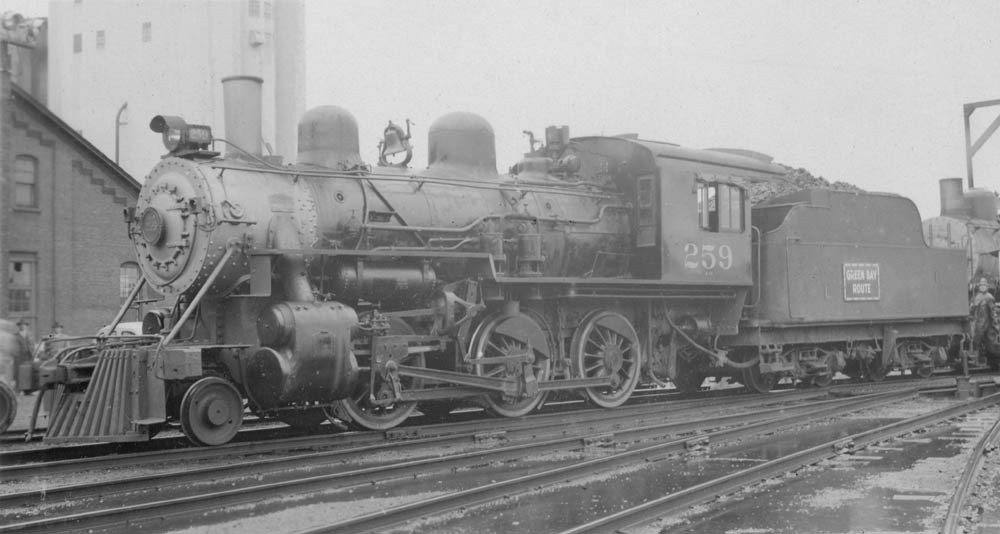 That the GB&W eventually relettered the two A&W locomotives for itself is illustrated by this undated view of the #259, formerly the A&W #39/#71. LeMar M. Kelley photo, Jeff Moore collection. 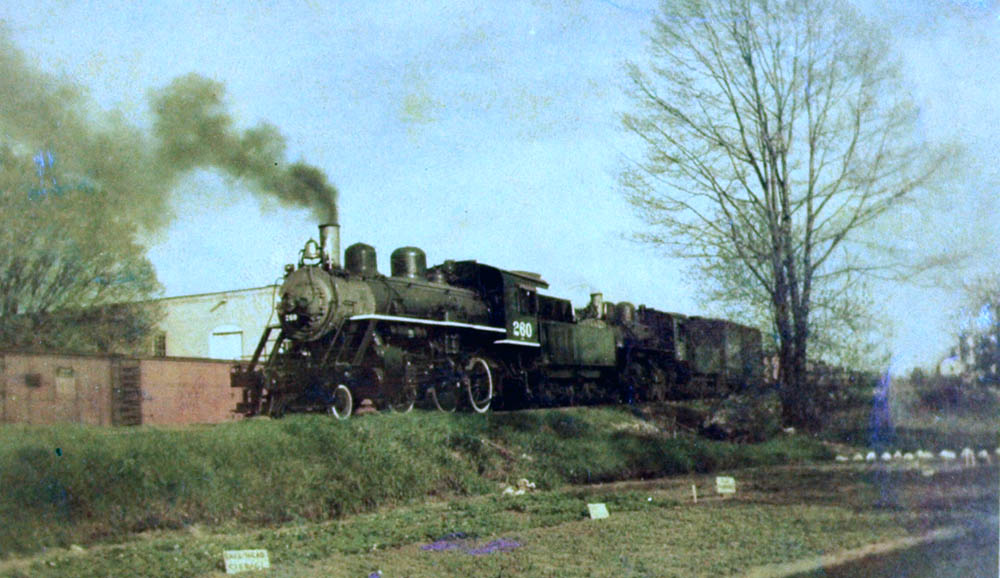 The first train the newly independent A&W operated on 31 May 1947, seen here at East Redwood Street in Sawyer. The Evangeline Milk Company is in the background. Locomotives #260 and #259, acquired with the road from the GB&W, ran with a passenger car carrying various dignitaries. It stopped at Casco Junction for photos and at Algoma for a luncheon and to switch out the Algoma Plywood plant. A&W Railway- John Poppy collection, courtesy Andy Laurent. 
In the winter of 1948 the #259 and #260 traded off duties monthly. The #259 is seen here on 5 February 1948 switching the Cities Service and Americal Oil spurs at the foot of Jefferson Street
in Sturgeon Bay. The Christy Corporation shipyard is visible in the right background. This locomotive would get a green A&W logo designed by Vern Bushman's daughter. Mailer-Luedke Collection,
courtesy Andy Laurent. 
The #259 was completely worn out by 1949, at which time the A&W turned to the GB&W for replacement power. The GB&W initially sold their large 2-8-0 #398 to the A&W. Alco
built the locomotive in 1923 as its construction number 64128 for the Kewaunee, Green Bay & Western as their #49, who renumbered it #398 in 1937. The A&W put the locomotive in service as their
#261 on 17 February 1949, but its 199,000 pound weight proved to be too heavy for the railroad. The locomotive made only 35 runs over the line before the A&W withdrew it from service on 30 November
1950. LaMar M. Kelley photo, Jeff Moore
collection. 
The A&W again turned to the GB&W for replacement power, and on 15 Novmeber 1950 the A&W bought the GB&W #351 for $6,000. Alco had built the locomotive for the GB&W in 1929 as their
construction number 67820, originally as #69 before being renumbered #351 in 1937. The #351 had the distinction of being the very last steam locomotive operated on the GB&W on 21 April 1950. The #351 and
#260 kept the trains rolling through the last summer of steam, rotating service monthly. In the early summer of 1952, which is about the vintage of this photo, the train crew worked six days a week, typically
between 2:00 and 5:00 p.m. The work hours changed to early in the morning after a new wage contractagreement came into effect on 17 July 1952. The tender of the #351 would have been painted a bright red at
the time of this photo. R.H. Carlson photo, Jeff Moore collection. 
In 1953 the A&W acquired two 70-ton diesel electrics new from
General Electric. The road numbered them 600 and 601 and painted them in this attractive scheme. K.C. Henkels shot this fine portrait of the #601 in
Sturgeon Bay on 6 September 1966. 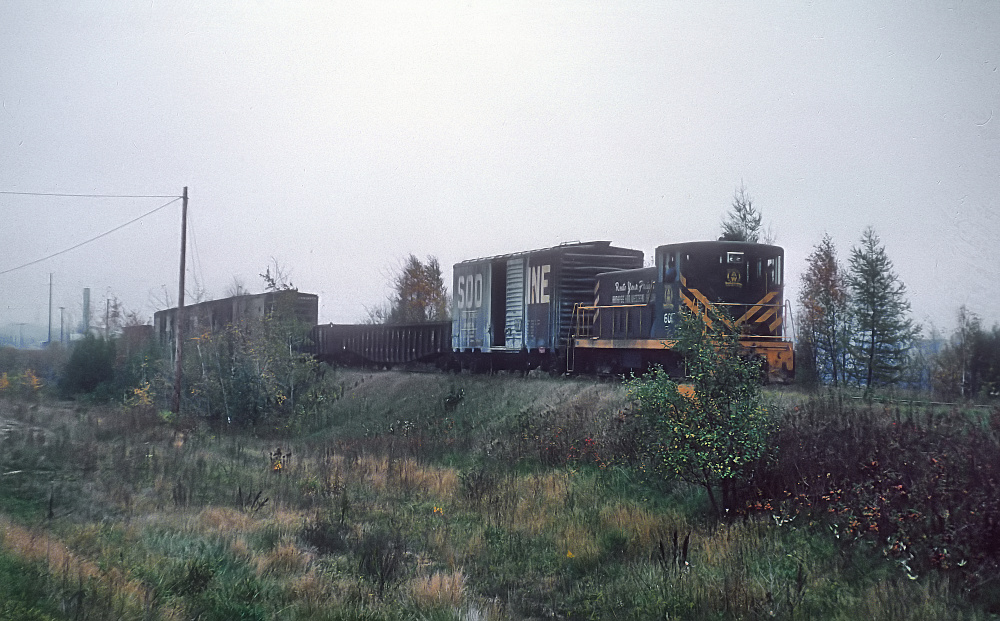
An AHW freight near Algoma on 19 October 1963. Rick Burn photograph, used with permission. 
An uncredited photo of AHW #601 switching in Algoma on 24 June 1968. Andy Laurent collection. 
A color shot of the other side of the #601, again on 24 June 1968. Andy Laurent collection. 
Another black and white view of the same view as above. Jeff Moore collection. 
New photo June 2025. One last undated photo of the #601 in Algoma. Jeff Moore collection. 
New photo September 2025. The Ahnapee & Western also owned some number of truck trailers which it used to expand its service beyond the railroad. The logo and lettering can still be seen on
this trailer in Green Bay on 20 August 1972. Jeff Moore collection.
A number of final straws hit in 1968, starting with the closure of the last substantial shipper in Sturgeon Bay. Then, in the aftermath of the collapse of the Silver
Bridge carrying U.S. Highway 35 over the Ohio River between Point Pleasant, WV, and Gallipolis, OH, on 15 December 1967 that killed forty-six people, the U.S. Department of Transportation in
cooperation with State highway agencies, American Association of State Highway Officials, the Association of American Railroads, and the U.S. Army Corps of Engineers, ordered an immediate safety
analysis of 511,000 state highway and 192,000 railroad bridges, giving first priority to those bridges built before 1935 carrying highway traffic and those which pass over deep ravines or water
"...where a collapse might result in catastrophic loss of like and property." The A&W bridge over Sturgeon Bay fell into the highest priority category and was among the first to be inspected,
resulting in its immediate condemnation in the spring of 1968. The railroad was thus immedately cut off from all remaining shippers in Sturgeon Bay, and on 24 May 1968 the company initiated
abandonment proceedings on the line north of Algoma. Some light storm damage gave the railroad the cover it needed to embargo the Algoma-Sturgeon Bay trackage on 8 August 1968. The Interstate
Commerce Commission granted the A&W permission to abandon the railroad north of Algoma on 7 January 1969, which it later upheld after denying a petition for reconsideration on 18 June 1969.
The railroad commenced salvage activities on 1 September 1969, and the #600, which had been stored in the enginehouse on the south side of the Sturgeon Bay bridge since the embargo, gingerly powered
the last train out of Sturgeon Bay on 4 September 1969. One of the constants in A&W's history had been a moderate sized forest products plant in Algoma. The plant first opened in 1892 right as the railroad reached town, and operated under a succession of names leading up to the Algoma Plywood & Veneer Company. United States Plywood Company purchased the plant in 1940, and it became the largest remaining shipper on the A&W after service to Sturgeon Bay ended. By this point, the A&W was in terrible shape, by physically and financially, and it was clear to all the line could not survive in its then form. U.S. Plywood, which had merged by this point into U.S. Plywood-Champion Papers, Inc (Ply-Champ), concluded the railroad was important enough to the continued operations of the Algoma plant that it decided to buy the railroad to preserve the service. 
Snip of a USGS Topo Map showing the general track arrangement in Algoma, with a few added notes. Not shown on the map is the small enginehouse the A&W built across the
tracks from the depot. 
An early postcard view of the plant, then operated as Ahnapee Veneer & Seating Company. 
Undated aerial view of the U.S. Plywood plant in Algoma, but probably taken at the same time as the 1949 view below. The original structure featured in the postcard is in the
middle of the photo, next to the creek. 
Aerial view of the U.S. Plywood plant in Algoma in 1949 looking generally west. 
Undated postcard view of the U.S. Plywood plant in Algoma. 
The U.S. Plywood plant in Algoma in 1960. 
Key staff at the Algoma plant in 1960.
One of the biggest obstacles to the sale was the A&W's accumulated debt, especially the $233,363.70 in unpaid car service and traffic balance obligations the company owed to over
fifty railroads as of 31 March 1970. Negotiations between the involved parties progressed, and by the later months of 1970 they had a deal. Ply-Champ agreed to buy
the A&W's operating rights and physical assets for $180,000 of their subordinated notes, with the money to be proportionally distributed amongst the car service and traffic
balance creditors. All debts above that amount would remain the responsibility of the old A&W company. The Interstate Commerce Commission approved the deal on 2 November 1970;
Bushman renamed the railroad to the Ahnapee & Western Transportation Company on 16 December; and Ply-Champ closed the purchase of the assets from the newly renamed company on
18 December 1970. The Ahnapee & Western Transportation Company lived on as a subsidiary of B&D (Bushman & Daanen, Vern Bushman's son-in-law) Warehouse in Green Bay, which
eventually paid off all of the other debts associated with the former railroad. Ply-Champ for its money got the 13.75 miles of the mainline between Algoma and Casco Junction, plus 2.64 miles of sidings and spurs; the two General Electric 70-ton diesel electric switchers; one Flexi-van intermodal flatcar; a Hart gondola outfitted with a snowplow; and one old bay window caboose. The McCloud River Railroad created The Ahnapee & Western Railway Company as a Division within the railroad's corporate structure to assume operations of the railroad. The various top McCloud River company officers assumed the same positions on the A&W. The new ownership almost immediately sent both of the diesels to the GB&W's shops in Green Bay for repainting into a variation of the orange and white worn by McCloud River's new SD38s. 
The A&W entry in the 1972 edition of the Official Railway Equipment Register reflects the road's status within the McCloud River corporate structure. 
A&W leadership in the early 1970s consisted of president Carl T. Hester, flanked on the left by Superintendent of Transportation Ted Gartzke and on the right by General Manager Jim Roubal.
Andy Laurent collection. 
The A&W #600 rests in Algoma in September 1971 immediately after being repainted into McCloud River's orange and white colors. Jeff Moore collection.  The invoice for painting the #600. Jeff Moore collection. 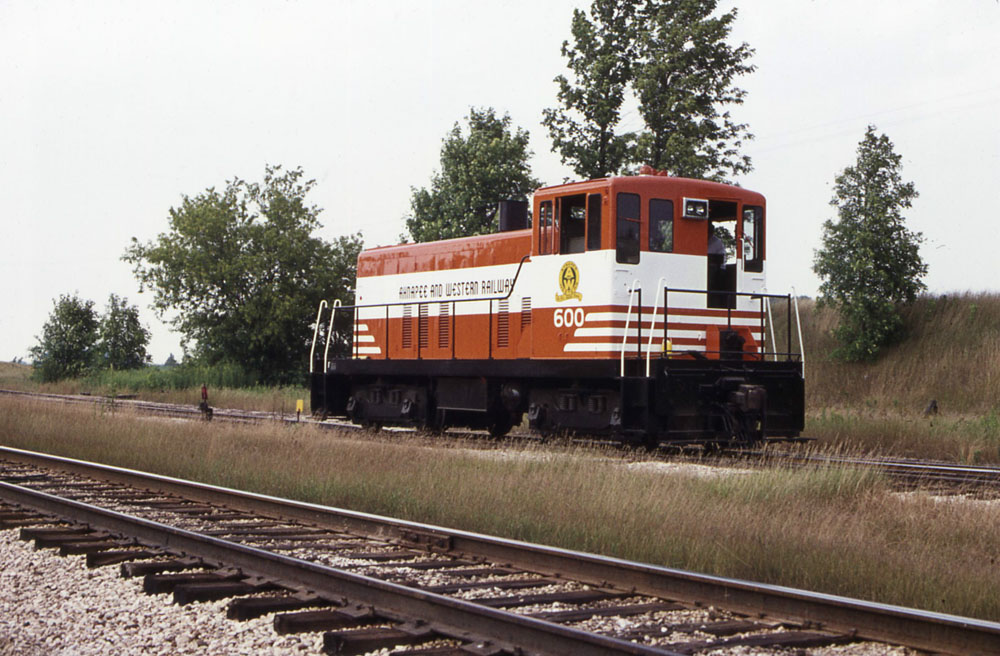 The freshly painted #600 switching at Casco Junction on 9 August 1971. Andy Laurent collection. 
One more photo of the #600 in Algoma in August 1971. The man on the steps is Ed Tomjanovich, A&W's long time diesel mechanic. Andy Laurent collection.
The A&W operated three trains a week over its line at the time it became part of the McCloud River. The new ownership decided almost immediately that the truncated operation required
only one of the 70-tonners, and Ply-Champ decided to send the #601 to the Moscow, Camden & San Augustine, another shortline railroad the company owned in Texas. The GB&W shops had
just painted the #601 at the time but had not yet applied the A&W lettering or logo; Ply-Champ instead ordered the locomotive lettered for the MC&SA and shipped it south from Green Bay
instead of back to Algoma. As noted, the A&W needed an end to end rebuild at the time Ply-Champ bought the line, and serious work to that end commenced in April 1971. The Green Bay & Western did most of the actual work on the project. Frank Stoller Construction Company provided most of the stone and gravel used. The A&W rented a backhoe and front end loader from the Alvin J. Tassoul Excavating Company, and the L.B. Foster Company provided a large number of angle bars. Lastly, the company called on the Krueger Construction Company for additional materials and equipment used in replacing two grade crossings in Algoma and rebuilding one side track. All told, Ply-Champ acting through the McCloud River invested $132,030.96 in rebuilding the A&W between April 1971 and June 1973. 
A&W #600 passing through Rio Creek on 11 August 1972. Note the GB&W ballast hopper right behind the locomotive. Tom Post photo, Jeff Moore collection.  Invoice from Frank Stoller Construction for some of the rock used in the rebuild. Jeff Moore collection. 
GB&W invoice for work done in June 1971. Jeff Moore collection. 
One of A&W's few pieces of equipment was this Hart bottom dump gondola equipped with a snowplow. The car had been built for the Wisconsin & Michigan Railroad and then sold to the Green Bay & Western
in the middle 1930s. The A&W acquired the car around 1965 and installed the Wausau highway truck plow to one end. The road used the car for both ballast dumping and spreading and plowing snow in the winter; it's seen
here dumping ballast at Casco Junction on 9 August 1971. Andy Laurent collection. 
Another 1971 view of the A&W crews dumping ballast at Casco Junction. Andy Laurent collection. 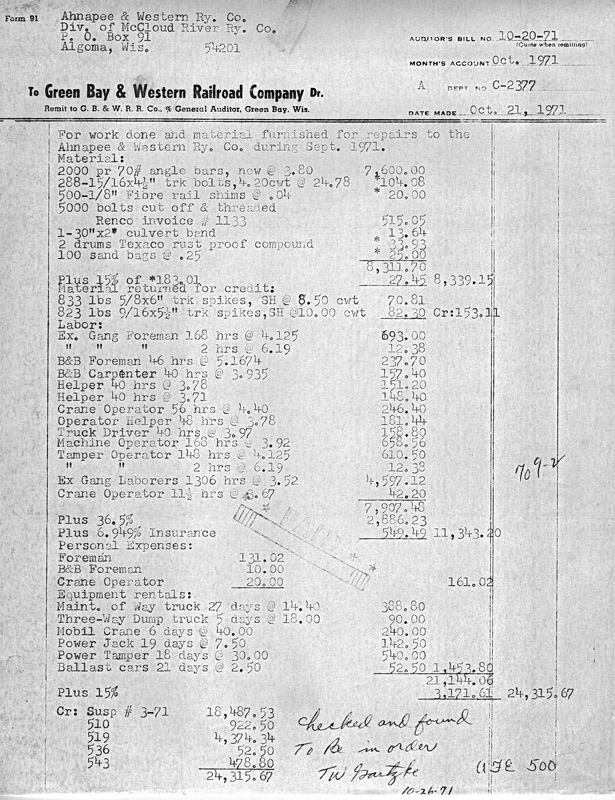 GB&W invoice for work done in September 1971. Jeff Moore collection. 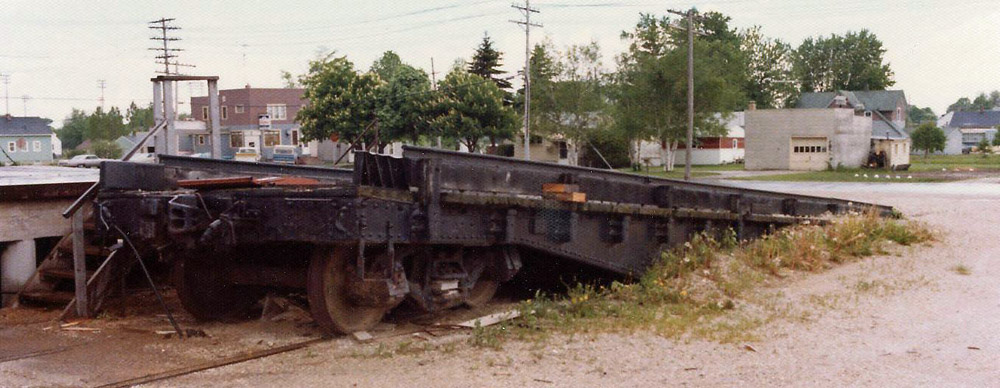
Among the circa 1971 projects was setting this old flatcar body up as a piggyback trailer loading ramp in the Algoma yard. Ply-Champ had long loaded truck trailers at Algoma which had previously been
driven to the Milwaukee Road's intermodal ramp at Green Bay. This ramp facilitated loading trailers on flatcars directly from the Algoma plant and boosted A&W's traffic for a while, but the increased
shipping times quickly caused Ply-Champ to divert the intermodal loads back to Green Bay. Andy Laurent collection.
The agreements with the Green Bay & Western to rebuild the A&W apparently led to more serious discussions, as on 14 December 1971
the McCloud River signed an agreement with the GB&W for that road to take over operating the short line. Working through the various
logistics associated with the deal stretched through 1972, and the A&W operated its last train as an independent road on 15 September 1972.
The first GB&W freight ran up the line to Algoma on 19 September, and thereafter trains operating to and from that company's ferry slips at
Kewaunee would make the side trip to Algoma as needed, usually two or three days each week. The A&W sold its remaining diesel and donated
its caboose to the National Railroad Museum in Green Bay. 
New October 2024. That the A&W didn't waste any time disposing of the #600 after ceasing independent operations is evidenced by this photo of the unit at General Electric's plant in Cleveland, Ohio,
on 24 November 1972, where it paused for some work while on its way to new owners in Mexico. McCown photo, Jeff Moore collection.

The Algoma depot on 13 October 1973, about a year after the GB&W assumed all operations. The A&W enginehouse is just visible to the right, and two cars are spotted for
customers at the team track beyond. 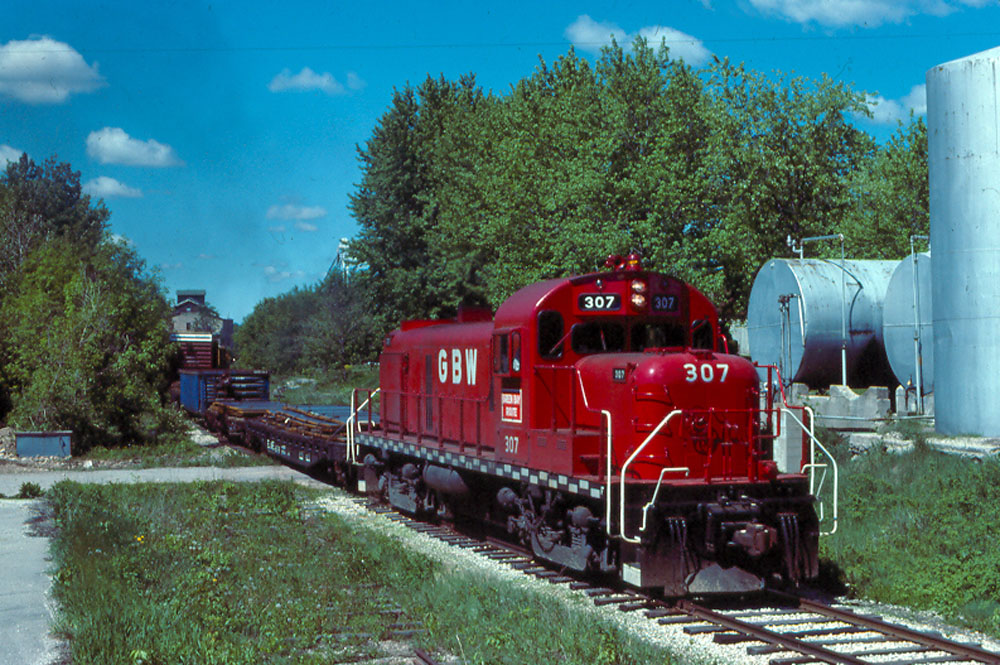 The GB&W #307 in Casco in 1985 with carloads of steel plates bound for Sturgeon Bay. Scott Janz photo.  Another shot of a GB&W freight bound for Algoma, this time in Rio Creek. Scott Janz photo.  The former A&W caboose on display in the National Railroad Museum in Green Bay. Jeff Moore collection.
The A&W thus lost its public face and identity, though the corporation remained part of the McCloud River Railroad. The situation remained stable
until 1976, which proved to be momentous in several ways. First, on 29 April 1976, the McCloud River reached an agreement with Trans Northern, Inc., allowing
that company to operate passenger excursions out of Algoma. Trans-Northern incorporated the Algoma Railroad, which operated its excursions in between GB&W's
by now twice weekly freights. The Algoma Railroad is detailed in a separate page in this section. The second major event that would rapidly change the A&W's
trajectory in 1976 happened when Ply-Champ's corporate successor Champion International shut the Algoma plant down. The closure of the Algoma plant proved short
lived as Champion sold it to a new local company, Algoma Hardwoods, Inc., which reopened the factory in March 1977. The third major event of 1976 occurred right at the end of the year when Champion International sold the McCloud River Railroad, including the A&W, to Itel Rail. The sale closed in April 1977 after Federal regulators blessed the transaction. Itel had started its corporate life primarily to lease incentive per diem boxcars to railroads, and then shortly expanded into shortline railroad ownership. The A&W remained a division of the McCloud River until 15 February 1978, when Itel incorporated a new Ahnapee & Western Railway Company to assume the assets. The new separate A&W remained a subsidiary of the McCloud River. On 1 April 1978 Itel executed the first of several boxcar leases to the A&W, which restored the railroad's name to railroad equipment after about a six year absence. Then, on 12 October 1978 the Interstate Commerce Commission approved Itel's acquisition of Green Bay & Western, and while various sources indicate ownership continued to rest with the McCloud River Itel replaced all of the McCloud officers from the A&W with GB&W people by late 1978 or early 1979. 
A&W boxcar #4022. All cars leased to the road carried the large AHW reporting marks but no other lettering. Jeff Moore collection.
The increasingly infrequent GB&W freights again had the A&W to themselves after the Algoma Railroad closed in 1979. The railroad in the last years served two primary shippers,
Algoma Hardwoods in Algoma and Bay Shipbuilding of Sturgeon Bay, the latter through a reload in Algoma. The company invested very little in track maintenance as the 1980s dawned,
resulting in increasingly poor track conditions and slower operations. Business levels on the railroad no longer warranted maintaining an office in Algoma, which closed on 15 December 1983,
after which all administrative and agent functions shifted to GB&W offices. The beginning of the end of the A&W came in March 1986. The railroad had originally crossed the Kewaunee River one mile north of Casco Junction with a 1,200 foot long trestle that was later replaced with a fill and a 50-foot long iron bridge resting on stone abutments. The river currents continually undercut the bridge's south abutment, and one of the regular maintenance items the A&W dropped in the later years had been to dump periodic carloads of protective stone or riprap around the abutment. This deferred maintenance caught up to the railroad when high river flows caused by heavy rain in March 1986 started undercutting the abutment and weakening the bridge. The last GB&W freight to Algoma removed all railcars from the A&W on 25 March 1986, and two days later the GB&W issued a notice of traffic diversion specifying that the Bay Shipbuilding reload would relocate from Algoma to Kewaunee while the Algoma Hardwoods traffic would shift to GB&W warehouses in Green Bay. The GB&W issued a track bulletin taking the A&W trackage out of service on 16 April 1986; however, the abrupt end of operations to Algoma caught the railroad with one last inbound carload still making its way towards Algoma, a load of sawdust from Texas bound for Plumbers Woodwork. The GB&W decided to accept the car due to the logistical problems associated with transloading the contents short of its intended destination. On 16 April, the same date the railroad took the line out of service, a GB&W trackmobile took the load, carried in car ATSF 14719, up the line to Algoma, and then returned the empty car to Casco Junction two days later. GB&W ran the abbreviated train with management personnel, resulting in a union claim for the movement. 
Algoma Railroad #100 leading a westbound passenger train towards Casco Junction over the Kewaunee River bridge. The abutment just visible to the right of the photo is the one that
failed in 1986 and ended operations over the line. Photo is from a Trans Northern history book.
The GB&W deemed the damaged bridge safe enough to hold up under empty cars, and as such started using the first part of the A&W main line to store cars, at first principally
A&W's fleet of incentive per diem boxcars idled by the economic downturns and the end of that program. The road would use a trackmobile to move cars onto or off the line, taking care
not to operate the vehicle over the bridge itself. However, by roughly 1987 or 1988 the river had further undercut the abutment, to the point the railroad concluded it was no longer safe
for even empty cars, and a trackmobile gingerly shoved all remaining cars north of the bridge back across it. GB&W continued to peridocially use the old interchange tracks at Casco
Junction and the first mile of the mainline for car storage for several years afterwards. Another flood washed the bridge out completely on 25 June 1990 and caused some other damage
to the line, and the GB&W operated a Jordan spreader up to the bridge to clear a mudslide and cut drainage ditches. 
A&W boxcars stored on the old main line at Casco Junction. Door County Historical Museum.
The A&W had reached the end of its line, and by 25 October 1990 the road had been officially declared "No Longer a Common Carrier".
Itel sold the A&W company, together with the Green Bay & Western and Fox River Valley railroads, to Wisconsin Central Railroad subsidiary Fox Valley & Western on 27 August
1993, and the A&W ceased its corporate existence on 19 November 1993. Scrappers finally removed the rails and other track materials from the line between September and October 1995,
and the State of Wisconsin promptly converted the grade to the Ahnapee State Trail. |
|
|
A&W Equipment Roster Locomotives- Only includes those A&W locomotives during McCloud River ownership. 600- GE 70-ton, c/n 31727, blt. 1/1953. 600 horsepower. Acquired new. Sold 11/1972 to Industrias Penoles, Mexico. Further disposition unrecorded. 601- GE 70-ton, c/n 31728, blt. 1/1953. 600 horsepower. Acquired new. Sold 7/1971 to Moscow, Camden & San Augustine #601, Camden, Texas; to Tex-Trax- Econorail Division #60, Port Arthur, Texas, 5/1984; Scrapped 2001. Incentive Per Diem Boxcars- As detailed elsewhere on this site under "normal" arrangements in the incentive per diem era a leasing company would own boxcars and lease them to a railroad. The deals were structured in such a way such that both parties benefitted from the incentive per diem revenues the cars earned. These typical arrangements did not always apply for those roads like the A&W that were owned by the boxcar leasing companies. Itel in particular tended to assign leases for its cars to the railroads it owned in between leases to other parties, and as such there were quite often large fluctuations in car numbers and types on the roster across years. McCloud River used the Ahnapee & Western's AHW reporting marks up to the point Itel reincorporated the A&W as an independent railroad in 1978. Itel probably sold the right to use the AHW reporting marks to GE Railcar along with the rest of its railcar fleet in 1991, but by 1994 they had been transferred along with the rest of what was left of the A&W corporate structure to the Fox Valley & Western. The AHW reporting marks remained registered through 2005. #300-#399: 100 50' single door cars, temporarily relettered from Angelina & Neches River to AHW circa 1995, then restencilled back to A&NR sometime after that. #301-#400: 100 50' single door cars, originally leased to Providence and Worcester, then assigned 28 January 1980 to AHW. Subsequently leased in 1983 to Bangor & Aroostook. #2000-#2099: 100 50' single door cars, originally leased in 1975 by Itel to Hartford & Slocomb. Lease assigned 1 April 1978 to AHW. Cars subsequently leased to Iowa Interstate or Escanaba & Lake Superior #4000-#4099: 73 50' double door cars, originally leased in 1977 by Itel to Hartford & Slocomb. Lease assigned 1 April 1978 to AHW. Lease for 25 cars assigned to Crab Orchard & Egyptian Railroad 1984. Lease for 70 cars assigned to McCloud River circa 1987. #4200-#4299: 100 50' cars, formerly Marinette, Tomohawk & Western cars, leased to AHW 1991-1993. #5000-#5010; 11 50' cars, Leased to AHW 19 September 1983. All off roster by 1994. Mark Mathu's Green Bay Route website also indicates two other possible boxcars series in the 41620-41674 and 42000-42099 series. No other information. 
MR #11161, formerly of the AHW 4000-series. The patch covers the AHW lettering. Jeff Moore photo. |
|
|
Algoma Plant Switchers In 1950, the A&W requested that U.S. Plywood assume some of its own switching chores so as to reduce the time its crews and equipment spent performing that task. U.S. Plywood and successors employed two small Plymouth switchers at the Algoma plant. c/n 3318, Model JLA-2, 97 horsepower, 12 ton, Gas Mechanical. Built 11 September 1929 for Cooper Bessemer Corp., Grove City, PA; to Algoma Plywood & Veneer Company; to Wisconsin Power Company, Necedah, Wisc.  The JLA-2 in 1950. Algoma Record-Herald Photo, Door County Historical Museum collection  The JLA-2 wearing its later paint scheme on 19 May 1961. Stan Mailer photo, Dan Luedke collection.
c/n 5724, Model DDT, 78 horsepower, 12 ton, Diesel. Built 12/3/1953 for The Hines Company, Crandon, Wisconsin; to Algoma Plywood & Veneer circa 1960; to U.S. Plywood Corp; to National railway Museum, Green Bay, Wisconsin.  The DDT shortly after arriving in Algoma. Andy Laurent collection.  A later photo of the DDT. Andy Laurent collection.  Bob Welke shot this photo of the DDT switching in Algoma in April 1977. |
|
|

In addition to his ownership of the A&W, Vern Bushman was also a long-time president of the National Railway Museum in Green Bay. The museum once painted this former Lake Superior &
Ishpeming Railroad coach for Vern's railroad and named it in his honor, even though it had no other connection to the A&W. The museum re-lettered the car for the LS&I by the middle 1980s.
Jeff Moore collection. |
|
|
|
Special thanks to Mark Mathu and Andy Laurent for their help with some information on this page. Other information gleaned from various sources, including corporate records, regulatory filings, Shortline Railway guides, and the book "Algoma Railroad" written by George A. Forero Jr. and published by Trans Northern in 1979. Links to other websites of interest. Pages will open in a new window. Ahnapee State Trail website Mark Mathu's Green Bay Route- Mostly about the GB&W, but has a good amount of A&W material. |
|
|